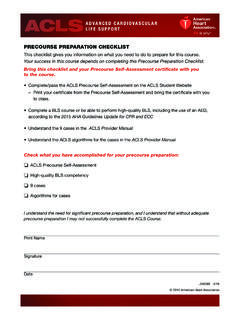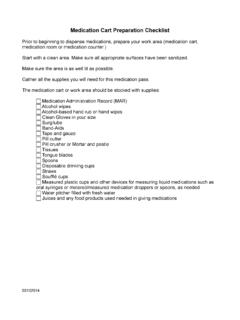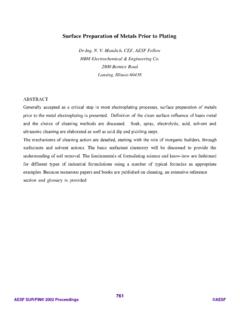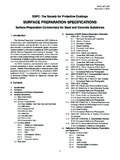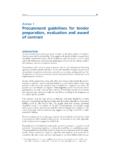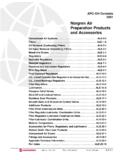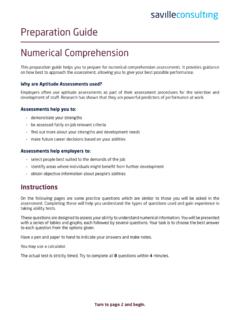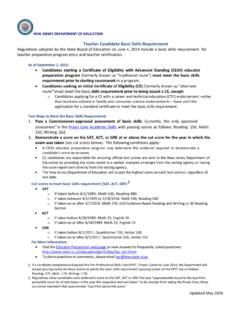Transcription of Guidelines - World Health Organization
1 Safe preparation , storage and handlingof powdered infant formulaGuidelinesWorld Health Organizationin collaboration with Food and Agriculture Organization of the United NationsWHO Library Cataloguing-in-Publication DataSafe preparation , storage and handling of powdered infant formula : Guidelines . World Health Organization in collaboration with Food and Agriculture Organization of the United Nations". formula. food - microbiology. contamination - prevention and control. sakazakii - pathogenicity. - pathogenicity. Health Organization . and Agriculture Organization of the United 978 92 4 159541 4 (NLM classification: WS 120) World Health Organization 2007 All rights reserved. Publications of the World Health Organization can be obtained from WHO Press, World Health Organization , 20 Avenue Appia, 1211 Geneva 27, Switzerland (tel.: +41 22 791 3264; fax: +41 22 791 4857; e-mail: Requests for permission to reproduce or translate WHO publications whether for sale or for noncommercial distribution should be addressed to WHO Press, at the above address (fax: +41 22 791 4806; e-mail: The designations employed and the presentation of the material in this publication do not imply the expression of any opinion whatsoever on the part of the World Health Organization concerning the legal status of any country, territory, city or area or of its authorities, or concerning the delimitation of its frontiers or boundaries.))
2 Dotted lines on maps represent approximate border lines for which there may not yet be full mention of specific companies or of certain manufacturers products does not imply that they are endorsed or recommended by the World Health Organization in preference to others of a similar nature that are not mentioned. Errors and omissions excepted, the names of proprietary products are distinguished by initial capital reasonable precautions have been taken by the World Health Organization to verify the information contained in this publication. However, the published material is being distributed without warranty of any kind, either expressed or implied. The responsibility for the interpretation and use of the material lies with the reader. In no event shall the World Health Organization be liable for damages arising from its in SwitzerlandThis document is published by the Department of Food Safety, Zoonoses and Foodborne Diseases, WHO, in collaboration with the Food and Agriculture Organization of the United Nations (FAO).
3 E-mail: Web site: World Health Organization , 2007 This document was prepared in collaboration with the Food Safety Authority of preparation , storage and handling of powdered infant formula - Guidelines Executive Summary iiAcknowledgements iiPart 1: Background Illness associated with PIF 2 E. sakazakii 3 Salmonella Populations at greatest risk of infection Contamination of PIF Breastfeeding recommendation Purpose Scope Assumptions behind the recommendations Training 6 Part 2: In Care Recommendations Use of infant formula General requirements Preparing a feed using PIF Preparing feeds in advance for later use Re-warming stored feeds Transporting feeds Holding and feeding times Rationale behind recommendations Choice of infant formula General requirements Good hygienic practice Cleaning and sterilizing feeding and preparation equipment Temperature of reconstitution water Volume of container for preparing batches Holding and feeding times Labelling of feed Storage of prepared feeds Re-warming stored feeds Transporting prepared feeds 14 Part 3.
4 In The Recommendations Cleaning and sterilizing feeding and preparation equipment Preparing a feed using powdered infant formula Preparing feeds in advance for later use Re-warming stored feeds Transporting feeds Rationale behind recommendations Good hygienic practice Cleaning and sterilizing feeding and preparation equipment Temperature of water for reconstitution Storage of prepared feeds Re-warming and use of stored feeds Transporting feeds Holding and feeding times 20 AppendicesAppendix 1 22 Appendix 2 23 Appendix 3 24 References Cited in the Text 25 Safe preparation , storage and handling of powdered infant formula - GuidelinesExecutive SummaryPowdered infant formula (PIF) has been associated with serious illness and death in infants due to infections with Enterobacter sakazakii. During production, PIF can become contaminated with harmful bacteria, such as Enterobacter sakazakii and Salmonella enterica.
5 This is because, using current manufacturing technology, it is not feasible to produce sterile PIF. During the preparation of PIF, inappropriate handling practices can exacerbate the the need to address such hazards in PIF, Codex Alimentarius decided to revise the Recommended International Code of Hygienic Practice for Foods for Infants and Children. In doing so it requested specific scientific advice from the Food and Agriculture Organization of the United Nations (FAO) and the World Health Organization (WHO). FAO and WHO have provided this advice in the reports of two expert meetings held in 2004 and 2006 on Enterobacter sakazakii and other microorganisms in powdered infant formula (PIF). Part of this advice included recommendation to develop Guidelines for the preparation of World Health Assembly (WHA) of WHO requested in 2005 the Organization to develop such Guidelines on the safe preparation , handling and storage of PIF in order to minimize the risk to FAO/WHO advice on E.
6 Sakazakii in PIF includes a quantitative microbiological risk assessment of E. sakazakii in PIF. One of the aspects of the risk assessment was to determine relative risk reduction associated with different preparation , storage and handling scenarios. The recommendations made in the present guideline document are largely based on the findings of the quantitative risk assessment. No risk assessment was carried out for Salmonella, but the group reported that the basic risk control principles for E. sakazakii would also hold true for S. general, sterile liquid infant formula is recommended for infants at the highest risk of infection. Where sterile liquid infant formula is not available, preparation of PIF with water at a temperature of no less than 70 C dramatically reduces the risk. Minimizing the time from preparation to consumption also reduces the risk, as does storage of prepared feed at temperatures no higher than 5 of PIF are made aware that powdered infant formula is not a sterile product and may be contaminated with pathogens that can cause serious illness.
7 Correct preparation and handling of PIF reduces the risk of present Guidelines are presented in two parts. One part provides guidance for the preparation of PIF in care settings where professional care providers are involved in the preparation of large quantities of PIF for a large number of infants. The second part provides guidance for the preparation of PIF in a home environment, aimed at parents and those involved in the care of infants in the home document provides specific guidance on the most appropriate practices in the different steps during the preparation of PIF in these two types of settings. Cleaning and sterilization of feeding and preparation equipment is an important prerequisite to the safe preparation of PIF. The specific guidance focuses on the most important parameters during preparation such as the temperature of reconstitution, the cooling, holding and feeding times, as well as the storage and transportation of prepared PIF. The rationale behind the recommendations is provided in both sets of World Health Organization would like to express its appreciation to all those who contributed to the preparation of these Guidelines .
8 Special appreciation is extended to the Food Safety Authority of Ireland and particularly to Judith O'Connor and Alan Reilly for their time, efforts and expertise provided in the elaboration of these Guidelines . Appreciation is also extended to the many people in more than 20 countries as well as several stakeholder associations who have provided their comments and suggestion following a call for comments issued through the International Food Safety Authorities Network (INFOSAN).The preparation of these Guidelines was coordinated by WHO in collaboration with FAO, with contributions from Peter Karim Ben Embarek, Jaap Jansen, Margaret Miller, Jenny Bishop, Janis Bernat, Fran oise Fontannaz, Jenny Murcott and J rgen Schlundt in WHO, with Sarah Cahill and Maria de Lourdes Costarrica in 1: IntroductionSafe preparation , storage and handling of powdered infant formula - Guidelines Background Illness associated with PIF E. sakazakii Salmonella Populations at greatest risk of infection Contamination of PIF Breastfeeding recommendation Purpose Scope Assumptions behind the recommendations Training 6 Safe preparation , storage and handling of powdered infant formula - GuidelinesPart 1: BackgroundIn 2004, the Food and Agriculture Organization of the United Nations (FAO) and the World Health Organization (WHO) met jointly in Geneva to convene an expert meeting on Enterobacter sakazakii and other microorganisms in powdered infant formula (PIF).
9 This meeting was organized in response to a request from the Codex Committee on Food Hygiene (CCFH) for input into the revision of the Recommended International Code of Hygienic Practice for Foods for Infants and Children (CAC, 1979). Based on the literature reviewed, the expert meeting concluded that E. sakazakii and Salmonella enterica were the organisms of most concern in PIF. The expert meeting conducted a preliminary risk assessment for E. sakazakii, which established that the inclusion of a pathogenic lethal step at the point of preparation ( reconstituting PIF with water at no less than 70 C) and a decrease in the holding time and feeding times would effectively reduce risk. Based on this preliminary risk assessment, the expert group made recommendations to FAO, WHO, Codex, member countries, nongovernmental organizations and the scientific community for minimizing the risk (Appendix 1). One recommendation was that Guidelines should be developed for the preparation , use and handling of infant formula to minimize the risk.
10 The World Health Assembly (WHA) of WHO, in 2005, in its Resolution WHA (WHA, 2005), requested the Organization to develop such Guidelines on the safe preparation , handling and storage of PIF in order to minimize the risk to second meeting of the FAO/WHO expert group was convened in January 2006, to address additional requests from the CCFH taking into consideration new scientific data (on E. sakazakii and S. enterica), and to apply a quantitative microbiological risk assessment model for E. sakazakii in PIF. This model had been developed since the first meeting in 2004. One of the aspects of the risk assessment was to determine relative risk reduction associated with different preparation , storage and handling scenarios. The recommendations made in this guidance document are largely based on the findings of the quantitative risk risk assessment was carried out for Salmonella, but the group reported that the basic risk control principles for E. sakazakii would also hold true for S.










